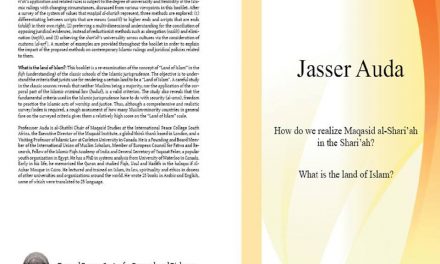
Question: Salam, I have been studying the Sunnah and the seerah in detail, but I still have difficulties differentiating the definition of Sunnah and seerah of the Prophet.
The Quran says, (And obey Allah and His messenger) (8:46) (So take what the Messenger assigns to you , and deny yourselves that which he withholds from you.) (59:7) From the Prophet: That after he passed away we ought to hold strongly Quran and his Sunnah so we will not be lost. And that Muslim will enter paradise except the one who refuses. The one who follow his Sunnah is the one who will enter Paradise, and the one who does not follow his Sunnah the one who refuses. The word, "obey" and the word, "refuse" are the result of an order. Is it true then, that only what the Prophet says is binding on us ? Thank you.
consultant: Jasser Auda
Answer
Salam, Bambang.
Thank you for your question.
In principle, what you are saying is absolutely what a believer in Prophet Muhammad (peace be upon him) should do. We should obey what is narrated in the prophetic tradition and not reject it.
However, it is important to know the type of prophetic tradition that the above statement applies to. Not every tradition is "religion" or "legislation" that has to be obeyed and followed.
Please allow me here to explain the difference between: 1) the Sunnah and the seerah and 2) three kinds of the Sunnah:(a) the Sunnah that is for us to follow literally, (b) the Sunnah that we should follow in only essence and meaning, and (c) the Sunnah that is specific to the Prophet and not for believers to follow.
1- The Difference Between the Sunnah and the Seerah
In terms of terminology, the Sunnah is the tradition of the Prophet that reaches us through the hadith collections, as narrated by the Companions and their students, whereas the seerah is the life story of the Prophet, which has reached us through history books written by historians, early and contemporary.
Both types of tradition are relating stories about the Prophet. However, the Sunnah, narrated through hadith narrations, had undergone an "authentication" process that was unique in human history.
Every narrator of any part of the prophetic hadith was examined for trustworthiness, and every hadith was examined for validity. The following are some technical details of this process that is meant to show its extensiveness.
Valid hadiths are classified into most famous, famous, and single-chained. Most famous narrations are as absolute as the Quran, according to all schools of thought, since they are narrated after a large number of companions (there are various estimates of the number "large"), who could not possibly and logically agree to lie.
Hadiths included in this category are related to Islam's most famous acts of worship (basic actions of prayers, pilgrimage, and fasting). The absoluteness of these narrations, according to all schools, implies an obligation on every Muslim to believe in them, and in addition, to practice them. The most famous narrations are very few. Estimates range from a dozen to eighty narrations.
The category of hadith which includes the vast majority of narrations is the "ahad" (single-chained) category, which scholars relied on in their derivation of their fiqh. These are narrations conveyed via one or a few "chains of narrations," usually with slightly different wordings. The verification procedures of the narrators and narrations are detailed extensively in the sciences of Hadith. (Ibn al-Salah)
Then, a valid narration has to be valid in terms of its chain of narrators (al-sanad) and its content (al-matn). For the content of a hadith to be acceptable, the main criteria is to be linguistically correct and not to be in "contradiction" with another hadith, "reason" or "analogy" in a way that cannot be reconciled. (Al-Khoshoui 74)
Then, authenticity of hadith "al-sihhah" (sound hadith) was judged based on the chain of narrators (al-sanad), and differences of opinion in judging the narration of hadith had implications on the law.
On the other hand, trusting a narrator entails a group of conditions for receiving or learning the hadith, and another group for conveying or narrating the hadith.
For being accepted as a bearer of a hadith, a narrator has to be mature (most estimates for his/her age is seven years old) and known to have a reliable memory (al-dabt).
For narrating a hadith, a narrator has to be mature, Muslim, pious, have a reliable memory, and have a connected chain of narrators/teachers between him/her and the Prophet (peace be upon him). The exact specifications of each of these conditions are subject to many differences of opinion amongst scholars of hadith, even within each school.
Regarding the hadith narrations themselves (of the degree ahad), they have to be conveyed in complete sentences. Moreover, they cannot contradict with other "certain" narrations or analogy. Nor can they contradict the narrator's practices or "reason". (Al-Basri 153)
The seerah traditions, however, did not go through such a rigorous process of verification or authentication. Therefore, it is a good source of knowledge about the general trends in the Prophet's life, but not a source of legislation.
2- The Difference Between the Three Kinds of Sunnah
The Islamic scholar, Imam Al-Qarafi, differentiated between different actions taken by the Prophet based on his "intents." He writes in his book, Al-Furuq [The Differences]:
There is a difference between the Prophetic actions as a conveyer of the Divine message, a judge and a leader … The implication in the law is that what he says or does as a conveyer goes as a general and permanent ruling … [However,] decisions related to the military, public trust, … appointing judges and governors, distributing spoils of war, and signing treaties … are specific to leaders. (357)
Therefore, Prophetic traditions which are narrated in the hadith and for his Sunnah fall under one of the following three categories:
1- The Prophet's direct conveyance of the message, that is, the intent of legislation. One example is the Prophet's sermon at the farewell pilgrimage, during which he reportedly said:
"Learn your rituals from me [by seeing me performing them], for I do not know whether I will be performing pilgrimage after this pilgrimage of mine." (Al-Albani, Sahih al-Jami` al-Saghir)
He, also, said after concluding the same sermon:
"Let those present inform those who are absent." (Al-Bukhari)
2- Traditions with specific "intents," other than the direct conveyance of the message. Related narrations should be understood and applied in the law in the context of the intent.
Imam Al-Qarafi, as mentioned above, differentiated between the capacity of legislation, judgment, and leadership.Examples for the intent of judgeship are:
1- the Prophet's (peace be upon him) settlement of the dispute between a man from Hadramawt and a man from Kindah regarding a piece of land;
2- the Prophet's settlement between the Bedouin and his adversary, when the Bedouin said: "O Messenger of God, judge between us;"
3- the Prophet's (peace be upon him) settlement between Habibah and Thabit. Habibah bint Sahl, Thabit's wife, complained to the Prophet (peace be upon him) that she did not love her husband and that she wanted to divorce him. The Prophet (peace be upon him) said: "Will you give him back his walled garden?" She said: "I have all that he has given to me." Then, the Prophet (peace be upon him) said to Thabit: "Take it from her." And so he took his walled garden and divorced her. (Ibn Ashur)
Examples of Sunnah with the intent of leadership (but not for general legislation to every Muslim) are:
1- the Prophet's peace treaty in Hudaibiyah that was bound to last for 10 years; neither the duration nor the details of the treaty is Sunnah in the sense of literal adherence.
2- the permission to cultivate and own barren lands; today this is something that every government has to legislate in their own way.
3- The distribution of the "spoils of war," which today takes the shape of army personnel salaries and benefits. And so on. (Abu Yusuf 14, 81)
3- Traditions that fall in the realm of human everyday decisions or actions, which Ibn Ashur had called, "the intent of non-instruction." This includes the hadith that described the way the Prophet ate, wore his clothes, laid down, walked, mounted his animal, and so on. These actions of the Prophet are even subject to human error. The following hadith explains:
Talhah, a Companion of the Prophet, narrates: I was walking with the Prophet when he passed by some people at the tops of their palm trees. The Prophet asked: "What are they doing?"
They answered: "Pollinating the male into the female."
He replied: "I do not think that this will be of benefit."
When they were told about what the Prophet (peace be upon him) said, they stopped what they were doing. Later, when the trees shed down their fruits prematurely, the Prophet (peace be upon him) was told about that.
He said: "If it is good for them they should do it. I was just speculating. So pardon me. But if I tell you something about God, then take it because I would never lie about God." Another narrator added: "You know your worldly affairs better than me." (Muslim)
I hope that the above details shed light on your question.
Salam.
Work Cited:
Abu Yusuf, Yaqub. Al-Kharaj. Cairo: Al-Maktbah Al-Amiriyah, 1885.
Al-Basri, Mohammad. Al-Mutamad Fi Usul Al-Fiqh. Ed. Khalil Al-Mees. Vol. 2. Beirut: Dar al-Kutub Al-Ilmiyah, 1983.
Al-Khoshoui, A. M. Ghayat Al-Idah Fi Ulum Al-Istilah. Cairo: Al-Azhar University, 1992.
Al-Qarafi, Shihabuddin. Al-Furuq (Ma`a Hawamishih). Ed. Khalil Mansour. Vol.1. Beirut: Darul Kutub Al-Ilmiyah, 1998.
Ibn al-Salah, Abu Amr. Al-Muqaddimah Fi Ulum Al-Hadith [Introduction to the Sciences of Hadith]. Beirut: Dar Al-Fikr, 1977.
Ibn Ashur, Muhammad ibn Al-Taher. Treatise on Maqasid Al-Shariah. Trans. Mohamed El-Tahir El-Mesawi. London-Washington: International Institute of Islamic Thought (IIIT), 2006.
====
Source: www.onislam.net — Ask about Islam — Jasser Auda.





